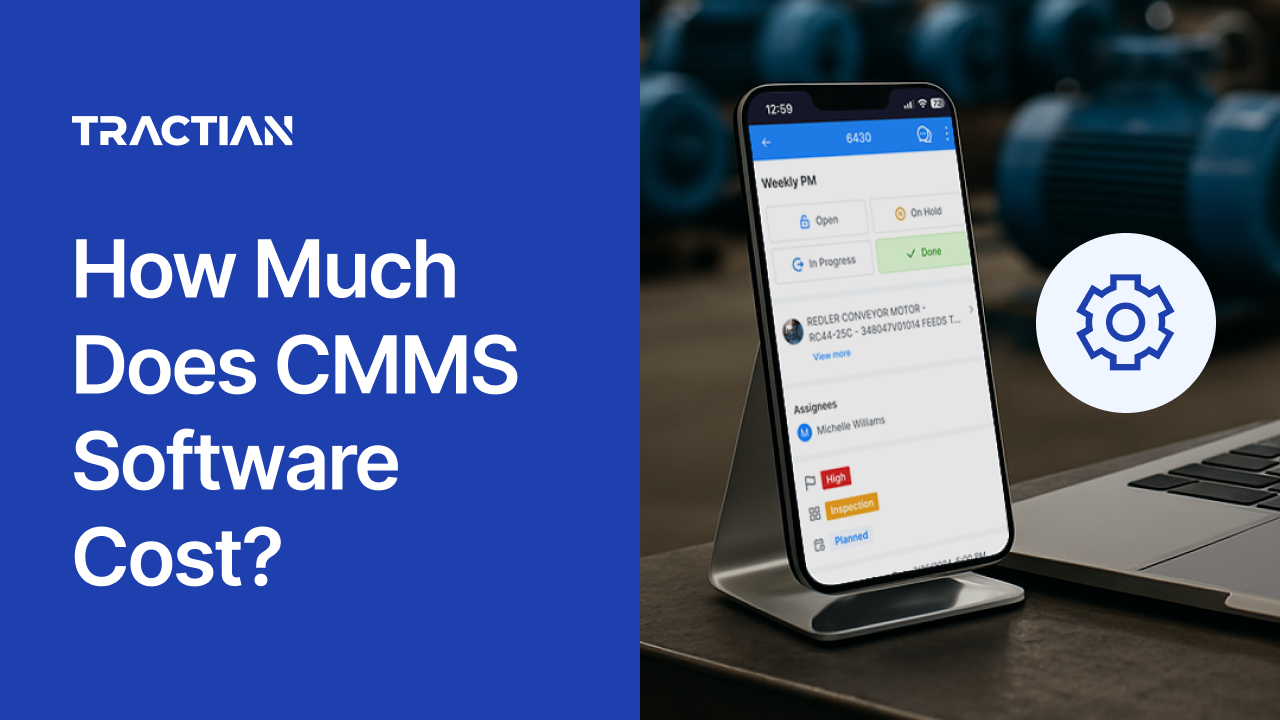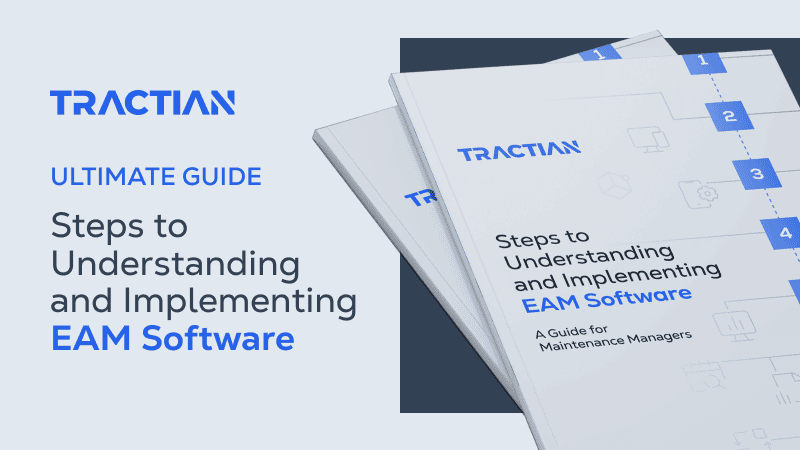Choosing CMMS software is never just about price. It’s about performance, adoption, and whether the software actually supports your team on the floor, not just in theory, but in execution.
Most vendors market low entry prices, but those numbers rarely tell the full story. Once implementation drags on, technicians avoid the system, or critical features are gated behind paywalls, the true cost becomes clear. And not just in dollars, but in downtime, disorganization, and missed work.
For maintenance managers, engineers, and plant supervisors evaluating CMMS platforms right now, this guide was built for you. It cuts through the pricing confusion, breaks down the hidden costs, and lays out exactly what you should be paying for and what you should be avoiding.
And you’ll also understand why the most affordable CMMS software might not be the cheapest, but the one that delivers real execution on the floor, without complexity.
Where CMMS Pricing Cost Actually Adds Up
Subscription fees are the headline, but they’re far from the full picture. The real cost of a CMMS lies in how well it fits your day-to-day operation. And that cost compounds quickly if the software doesn’t help your team execute in real time. Here’s where CMMS pricing gets complicated:
Deployment Models: Cloud vs. On-Premise
Cloud CMMS gives you speed and flexibility. On-premise systems often promise control, but they also come with baggage, manual updates, IT support, and risk of stagnation.
| Model | Speed to Deploy | IT Overhead | Best For |
|---|---|---|---|
| Cloud-Based | Immediate | None | Fast-growing, mobile-first operations |
| On-Premise | Weeks to months | High | Regulated or legacy infrastructure setups |
Tractian is a cloud-first system with zero infrastructure lift, automatic updates, and native mobile execution. You’re not managing the software, you’re using it.
Licensing Structures and User Types
Some providers charge by user, others by site. Some count active technicians, others include requesters and administrators. But it’s rarely transparent.
And many platforms introduce different license levels: technician vs. manager, planner vs. admin. On paper, it looks flexible. In practice, it’s often limiting especially when someone on the floor needs visibility but gets blocked by licensing tiers.
At Tractian, every user regardless of role gets access to the full functionality from day one. No paywalls. No permissions loopholes. This kind of access is what separates enterprise CMMS software from tools that only scale in theory.
Feature Tiers That Hide the Real Price
The most common pricing trap: Basic, Standard, and Enterprise plans where the base tier only includes asset lists and work orders. If you want real-time KPIs, mobile execution, or automated reports, you’re told to upgrade.
And that’s where the real cost begins because now you’re paying double just to make the system usable.
Tractian includes everything from the start: mobile offline access, AI-generated SOPs, backlog dashboards, real-time KPIs, and unlimited support.
Integration and Customization
CMMS tools that don’t integrate easily with your ERP, inventory system, or sensors often leave your team duplicating data, chasing updates, or building manual workarounds.
Some vendors offer APIs for a price. Others require third-party developers to build custom bridges, each with their own cost and complexity.
Tractian easily integrates with the tools your team already uses, keeping your workflows in sync without the hassle of complex IT integrations.
Implementation and Adoption
Every week a CMMS sits in implementation limbo is a week of backlogs, missed PMs, and manual logs that fall through the cracks.
Slow onboarding doesn’t just delay ROI, it kills momentum.
With Tractian, setup is fast, and adoption is built in. You’re not dragging your team through endless training. You’re deploying a system that’s intuitive from day one, with UX designed for technicians, not software buyers.
Support, Scalability, and Surprises
It’s easy to miss the fine print. Support hours. Ticket response times. Access to onboarding specialists. Multi-site visibility. Role-based permissions. These are often hidden behind expensive enterprise tiers.
With Tractian, every customer, whether they manage one site or ten, gets full access to onboarding, support, and platform capabilities. Cost should never scale faster than performance.
Different CMMS Pricing Models, Explained
CMMS platforms don’t follow one pricing standard. They bundle features, charge by users, gate capabilities, or stack costs based on usage, and it’s rarely straightforward. Knowing how each model works is the first step to avoiding surprises after you sign.
| Model | Predictability | Scalability Risk | Common Pitfalls |
|---|---|---|---|
| Per-User Subscription | High | Medium | Cost balloons with adoption, minimum user requirements, auto-renewals, or license bundles you don’t need. |
| Tiered Feature Plans | Medium | High | Plans that sound flexible but hide the tools your team actually needs. |
| Usage-Based Pricing | Low | High | Unpredictable bills, especially during peak production cycles. |
| Perpetual License | High (upfront) | Low | High upfront investment, long implementation cycles, and limited vendor support. |
| Tractian’s All-Inclusive | High | Low | No hidden modules or access fees. |
Per-User Subscription
This is the most common setup: a fixed monthly (or annual) fee per user. It sounds simple, but it adds up quickly, especially if your technicians, supervisors, and planners all need access. Some vendors offer different user types (e.g., admin vs. technician) at different prices, but that often comes with permission limitations.
Good for: teams with clear access roles and stable headcount.
Watch out for: minimum user requirements, auto-renewals, or license bundles you don’t need.
Tiered Plans Based on Features
You’ll see this everywhere: Basic, Professional, Enterprise. Each tier unlocks more functionality, but the essentials are rarely all in one place. You might need the top-tier plan just to get advanced reporting dashboards, mobile execution, or API access.
Good for: companies that only need basic asset and work order tracking.
Watch out for: plans that sound flexible but hide the tools your team actually needs.
There are exceptions, of course, like Tractian, which delivers full functionality from entry-level plans: AI execution, technician-ready mobile UX, dashboards, and onboarding. But that’s not the industry norm.
Per-Asset or Usage-Based Pricing
Less common, but some vendors charge based on the number of assets in the system, the amount of digital storage it takes up, or the volume of work orders processed. This model might look cheaper upfront but becomes unpredictable if your operation is growing or seasonal.
Good for: not a lot of assets, project-based environments.
Watch out for: unpredictable bills, especially during peak production cycles.
On-Premise Licensing (Perpetual License)
Pay once, host it yourself. On-prem CMMS used to be the standard in large enterprises, but it requires internal servers, IT support, and manual updates. You own it, but you manage everything.
Good for: companies with strict data control policies or isolated networks.
Watch out for: high upfront investment, long implementation cycles, and limited vendor support.
Hybrid or Custom Pricing
Some vendors mix models, charging a base subscription plus per-module fees. Others customize everything for enterprise clients, quoting based on asset types, plant size, or number of users.
Good for: large, complex operations with tailored needs.
Watch out for: unclear contract terms and support tiers that only apply post-sale.
CMMS Software Price Comparison
Most CMMS pricing isn’t public. Vendors ask you to “book a demo” or “talk to sales” before you can get a number. But if you're budgeting for a platform right now, you need a baseline, and not just for subscription fees, but for what’s actually included.
Here’s a snapshot of what you can expect to pay based on public 2025 data from leading providers:
| CMMS Provider | Starting Price (Per User/Month) | Free Plan | Notable Details |
|---|---|---|---|
| UpKeep | $20 (Lite Plan) | No | Mobile-first. Advanced features start at $75. |
| Limble | $28 (Standard Plan) | Yes | Essentials like analytics locked behind higher tiers. |
| Fiix | $45 (Basic Plan) | Yes | Predictive maintenance in premium plans only. |
| eMaint | $69 (Team Plan) | No | Minimum user requirements apply. |
| Hippo CMMS | $35 (Starter Plan) | No | Tiered features and limited integrations. |
| MicroMain | $99 (Admin License) | No | Offers both cloud and on-premise options. |
| Tractian | $60 (Standard Plan) | No | All plans include mobile offline mode, AI-generated SOPs, real-time dashboards, and onboarding. No extra fees or feature lock-in. |
For a deeper breakdown, check out the 5 Best CMMS Software for maintenance teams.
These prices may not include onboarding, support, mobile access, or reporting capabilities. Many vendors list low entry prices to appear competitive, then charge extra for essential features like technician tracking, custom reports, or integration support.
Therefore, the final monthly cost per user can end up 2–3x higher than the advertised entry plan, especially when scaling across multiple users or facilities.
Explore Affordable CMMS Solutions
If you’re working within a lean budget or just want more transparency before committing to a platform, we’ve compiled a list of 10 affordable CMMS software options to help you compare platforms.
That said, affordability doesn’t always mean completeness.
The sticker price is just the starting point. What you’re really paying for is whether the software performs at full capacity without requiring upgrades to do the basics.
How to Budget for the Right CMMS
Spending $30/user/month on a tool that sits unused is more expensive than $60 on one that drives action. Your CMMS isn’t a static cost. It’s a bet on better uptime, clearer planning, and on a team that moves from reactive maintenance to proactive maintenance.
Budget for the result. Not just the license.
Start by asking:
- Will my technicians actually use this?
- Can I see our backlog, completion rates, and PMs without exporting reports?
- Is this system still useful at twice the size in six months?
If the answer to any of those is no, your cost isn’t what you paid. It’s what you’ll keep losing.
Start with Criticality, Not Just Cost
Map your budget to asset risk. What’s the cost of an hour of downtime on Line 1? What does a single missed PM mean for compliance? If a CMMS can’t reliably prevent failure on those fronts, it's already costing you more than it saves.
Factor In the Cost of Inaction
Sticking with spreadsheets, legacy tools, or half-adopted software means unlogged failures, delayed inspections or even reactive maintenance that throws off the entire shift.
Budgeting isn’t just “what can we afford.” It’s “what will it cost us to keep doing it this way?”
Know What You're Actually Paying For
Your subscription should include:
If it doesn’t, you’ll end up paying for those gaps, either with extra vendor fees or internal workarounds that burn time.
Check for Scale and Flexibility
Your operation won’t look the same in 6 or 12 months. Can the CMMS adapt without turning into a new implementation project? Can new plants or technicians onboard without process slowdowns?
Systems that scale quietly in the background are the ones that deliver ROI, not just features.
When your CMMS budget is aligned with execution, not just software, it becomes easier to justify, easier to defend, and far more likely to pay off. And that leads directly to what should guide the final decision: what your team actually needs to work better, every day.
What Maintenance Teams Actually Need in a CMMS
If your technicians aren’t using the system, the system doesn’t matter.
A functional CMMS isn't about dashboards or databases, it’s about execution. About removing friction from daily work. About making every task, inspection, and follow-up easier to do, track, and improve.
Here’s what that looks like in practice:

1. Mobile-First Design That Works Offline
Technicians should be able to access everything with their mobile CMMS app. From PMs to SOPs, directly from the floor. No laptops, no Wi-Fi dependency. If a CMMS doesn’t work offline, it doesn’t work in real life.
2. Live KPI Tracking and Backlog Visibility
You shouldn’t need a spreadsheet to figure out where your operation stands. Look for CMMS systems that provide good maintenance reporting and dashboard capabilities that can track MTTR, MTBF, task completion rates, and asset availability in real time, so you can spot issues before they turn into bottlenecks.
3. Structured SOPs from the Start
The most effective teams don’t rely on memory. A modern CMMS should allow you to build repeatable checklists based on asset type, failure mode, or even past technician input, turning tribal knowledge into standard practice.
4. Preventive Maintenance That’s Actually Executed
Time-based scheduling is the baseline. But the real value is in creating PMs that match reality: usage-based triggers, technician bandwidth, asset criticality. And having a system that tracks compliance automatically.
5. Execution History Without Admin Overhead
Technicians shouldn’t need to write a report for you to know what got done. The right CMMS logs work order execution in real time: who did what, how long it took, and what parts were used.
6. Zero-Friction Onboarding
If your team needs weeks of training or outside consultants just to run the basics, you’re paying for complexity. Adoption depends on speed, clarity, and how well the system reflects the way your team already works.
Why Tractian Leads in CMMS Software Cost & Value
Most CMMS tools are designed the same way: built for desktop use, then slowly adapted for the floor. They require hours of configuration, paid onboarding, and constant management to stay usable.
Tractian flips that model.
It’s designed around execution, what technicians need to get the job done, and what supervisors need to stay ahead of problems without extra admin overhead.
| Feature | Tractian | Typical Competitors |
|---|---|---|
| Offline-Ready Mobile UX | Included | Often requires upgrade |
| AI-Generated SOPs | Included | Rare or requires manual setup |
| Real-Time KPI Dashboards | Included | Locked behind premium tiers |
| Full Onboarding & Support | Included | Often paywalled or limited |
| Transparent, Flat Pricing | Yes | Requires sales consultation |
Here’s what sets it apart:
Built for Technicians First
Tractian isn’t a desktop-first interface with a mobile add-on. The entire experience is mobile-native, offline-ready, and designed to run directly from the floor. No waiting to get back to a computer, no excuses for unlogged work.
Execution Powered by AI, Not Just Checklists
Where other CMMS platforms upload static SOPs, Tractian dynamically generates them. It learns from failure modes, technician actions, and recurring issues, turning tribal knowledge into standardized execution steps without extra lift from your team.
Zero Hidden Fees
Every plan includes the essentials: real-time dashboards, mobile use, full reporting, AI-generated SOPs, and onboarding. No premium tiers for visibility. No surprise charges to get basic functions running. What you see is what your team uses.
Fast to Deploy, Faster to Adopt
You can import existing work orders, assets, and parts from Excel with structured migration support. Teams get up and running in days, not months. From the first login, every task and alert is tied to your real equipment, not demo placeholders.
Real-Time Maintenance Intelligence
Instead of hunting for reports or exporting CSVs, Tractian delivers real-time KPIs like MTTR, asset availability, and backlog by technician or failure type, so you’re not just tracking tasks, you’re improving execution.
How to Choose the Right CMMS Software
There’s no one-size-fits-all answer. But there is a right way to make the decision.
Choosing a CMMS means balancing cost, usability, and long-term reliability. It means understanding how each option impacts your technicians, your KPIs, and your ability to prevent failure, not just track it.
Here’s how to approach that choice with clarity:
1. Map Features to Daily Execution
Start with what happens on the floor. Can technicians log tasks without needing a desktop? Do planners get visibility into overdue work without chasing reports? Does the system support your team’s rhythm, or interrupt it?
2. Clarify Total Cost
Factor in everything: implementation, training, support, feature access, scalability. Don’t settle for budget-friendly software that becomes operationally expensive six months later.
3. Look for Systems That Adapt to Your Growth
The best CMMS doesn’t need to be replaced when you expand. It scales with your teams, your assets, and your goals, without losing simplicity.
4. Prioritize Adoption Above All
If your technicians can’t or won’t use it, none of it matters. The most powerful system is the one your team uses without resistance, because it actually helps them do their job.
This is where Tractian fits in.
It’s built to meet the needs you’ve read about across this guide: technician-first usability, full visibility without extra fees, AI-driven execution, and deployment that doesn’t drag. For teams looking to move past fragmented workflows and legacy tools, this is the new standard.
Unlike most systems, Tractian doesn’t separate planning from execution, or leave performance tracking buried behind reports. It turns work orders into smart routines, SOPs into guided actions, and backlog into a real-time snapshot of where your operation stands. It’s not just software, it’s a system built to drive reliability from the floor up.


